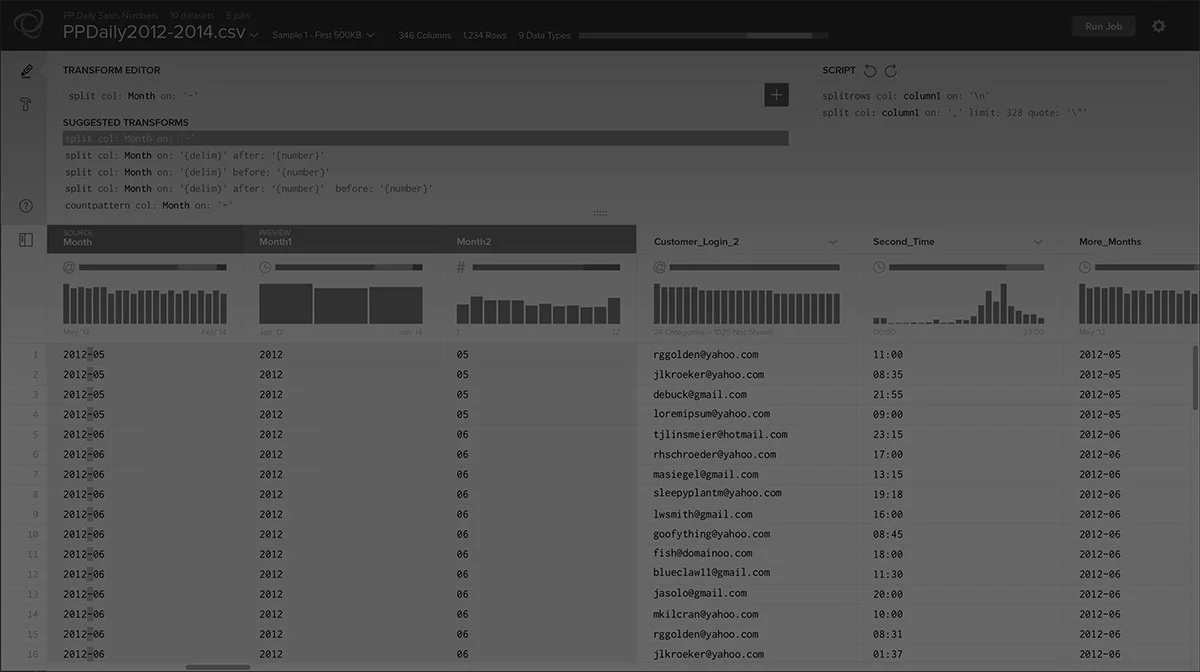Overview
Product & Project summary
Founded by professors from Berkeley and Stanford, Trifacta builds enterprise software that helps people clean and structure terabytes of data in a fraction of the time it currently takes.
Trifacta is an engineering-led organization. I joined as employee #13 and the first designer. Enterprise software is ripe for good design and an early stage startup was a great place to try out different ways to affect change. By the time I left, we had grown to ~60 employees and a 5 person design department.
Role: Senior UX Designer
Led visual and interaction design of core product
Led all UX research usability studies
Led multiple ideation and alignment workshops including company-wide core values workshop
Managed interns and mentored other designers
Team: VP of UX, me, 2 additional UX designers, 1 visual designer
Work spans ~ 18 months
A slight revamp of the primary Trifacta workspace. Design changes reflect both a different interaction model direction and tweaked visual design direction. This design is not in production, but was an extension of other work I did on a new interaction model for the product.
What is Design at Trifacta?
The familiar
Quick Redesign
I started at Trifacta by overseeing a visual skinning of the product with an external vendor and our second designer. We grounded the application with top-level navigation, a master-detail listing of projects, and clearer calls to action. We moved the styling away from Bootstrap and implemented light changes to the interaction model.
BEFORE
“I started at Trifacta by overseeing a visual skinning of the product with an external vendor...”
AFTER - These designs are not in production but rather are mockups I completed based on the original vendors work.
The not-so familiar
Designing for Agile
Design at a startup means moving fast. After rounds of slow, consultancy-style deliverables, I developed a toolkit of faster ways to deliver designs. One of my current favorite methods is high-level whiteboard sketching as presentation. Instead of reviewing designs in meetings, we revise designs in meetings. This frees me for other projects and takes the burden of documentation (both in creation and in consumption) out of the equation.
“Instead of reviewing designs in meetings, we revise designs in meetings”
Joins Example
So what is a SQL join? A common need during data prep is the ability to take two sets of data and combine them into one. For example email addresses might be used as a unique identifier for a CRM (customer relationship management) database. Two datasets - weblogs and the CRM database could be combined or joined into one dataset using email address as the shared identifier.
The work for the Joins feature spanned two vastly different versions, two different teams, and shifting requirements.
The v1 feature was designed and developed by myself and our CTO in an afternoon whiteboard session just three weeks before the code freeze for our V1 launch of our full app.
Joins v2 was a significantly longer project – 12 weeks – with a much larger team including a product manager, an engineering lead, a frontend engineer, and a backend engineer.
I led design and major parts of both releases including:
Requirements gathering
Ideation and sketch sessions
Interaction and visual design
Multiple rounds of usability testing on both designs
Prioritization with Engineering
Final retrospective
What Might Be Design at Trifacta?
SKETCH & IDEATION SESSIONS
Starting with a sketch lesson and following with regular ideation sessions, our engineers have become engaged and excited about contributing ideas through sketching.
After proving the utility over time, I’ve been able to introduce highly structured creative activities where participants have fun, designers get inspiration, and the company culture establishes a deeper foundation in design process.
core values
When a company nearly triples its size in half a year, things get weird. With a new CEO, a new sales team, and no stop in the hiring clip, it was about time to put down on paper what Trifacta values.
Core Values help companies make decisions, retain the early positives of company culture, and provide guidelines for hiring future employees. I planned, prepped, and facilitated a company-wide workshop to provide everyone with a platform to express their opinions on what it means to work at Trifacta and where we should go in the future.






